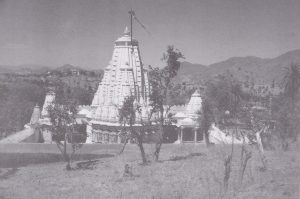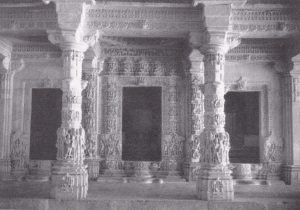Kumbharia
The five temples at Kumbharia, three kilometres beyond the popular holy Hindu site of Ambaji and the second destination of our grand tour, are a delight to the pilgrim with a camera. A written permit to photograph is freely obtainable from the manager of the temples.
The first impression that awaits the visitor to Kumbharia is an air of tranquillity which pervades the extensive temple compound located a short way off the road. Some kind of blessing seems to have saved these five temples – the first was consecrated in 1061, the last in 1231 from destruction at the hands of vandals, a fate that befell an unknown number of shrines which once dotted this area, then named Arasana.
One source speaks of over three hundred Jaina temples of which nothing was left standing. It was here that the white marble required for building the temples on Mount Abu and other places was mined; it is still being excavated in great quantities.
An inscription in the Mahavira temple, the earliest of the five, reads: “On Monday, the 9th of the bright half of Phalguna, in Samvat 1118 (AD 1061) at a place known as Arasana, the image of Vira (Mahavira), to the memory of whom the place is sacred, was consecrated.”
The other four temples are dedicated to Shantinatha, Parshvanatha, Neminatha and Sambhavanatha respectively. All are in active worship for the benefit of pilgrims; as many of them travel long distances, the management provides lodging and cooking facilities. The nearest town is Ambaji. about 2.5 kilometres to the west.
The figura- tive carvings at Kumbharia resemble those seen in the Dilwara temples, but the structural lines follow a sober angular design. The marble used is of a yellowish tone.
233. Kumbharia. Neminatha Temple, consecrated 1136.
“The next Jaina temple of this style is the magnificent marble temple of Mahavira built in 1061 at Kumbharia, which has also four other Jaina temples.(…) The interior of the temple is exquisitely finished and excels even the Vimala temple at Abu in porportion and unity of conception.”
Krishna Deva
“The Kumbharia (Mahavira) temple also contains in one of its ceilings long panels showing figures of the mother and father of each of the twenty-four Tirthankaras, all having inscribed labels giving their names. The panels in the temple at Kumb- haria are masterpieces of art in rendering miniature figures of gods, men, women, animals, trees, etc., in marble. Artists of this region in the eleventh and twelfth centuries were experts in the minute chiselling of soft marble.”
Next in time to the Vimala-vasshi temple (1831-32) at Dilwara on Mt Abu (the editor). See page 230 Both quotations from A. Gosh Jana Art and Architecture Vol. 1, 302 and 307/8 respectively
U. P. Shah
